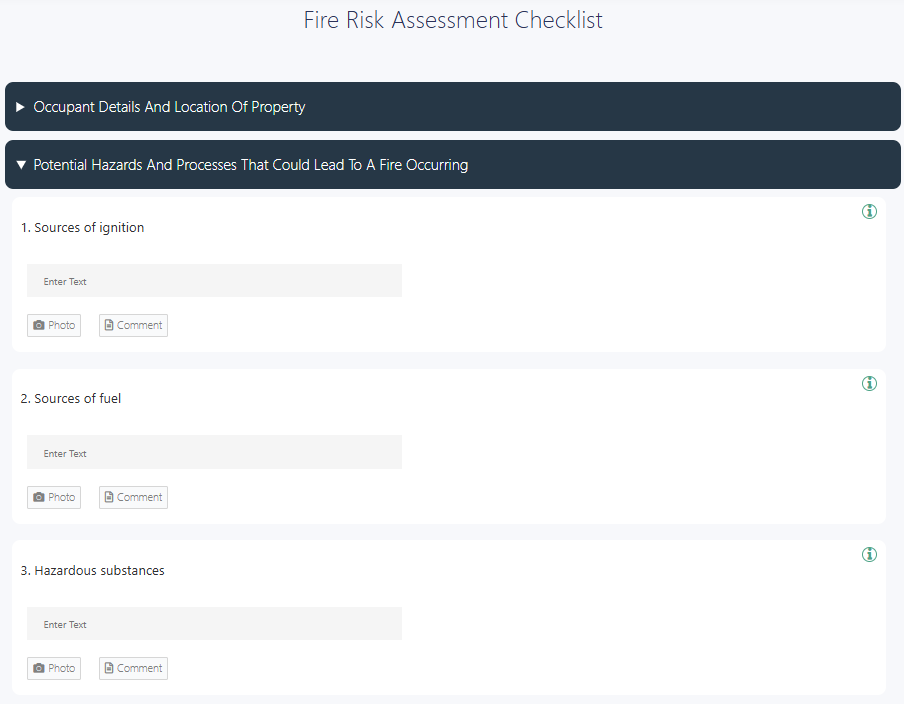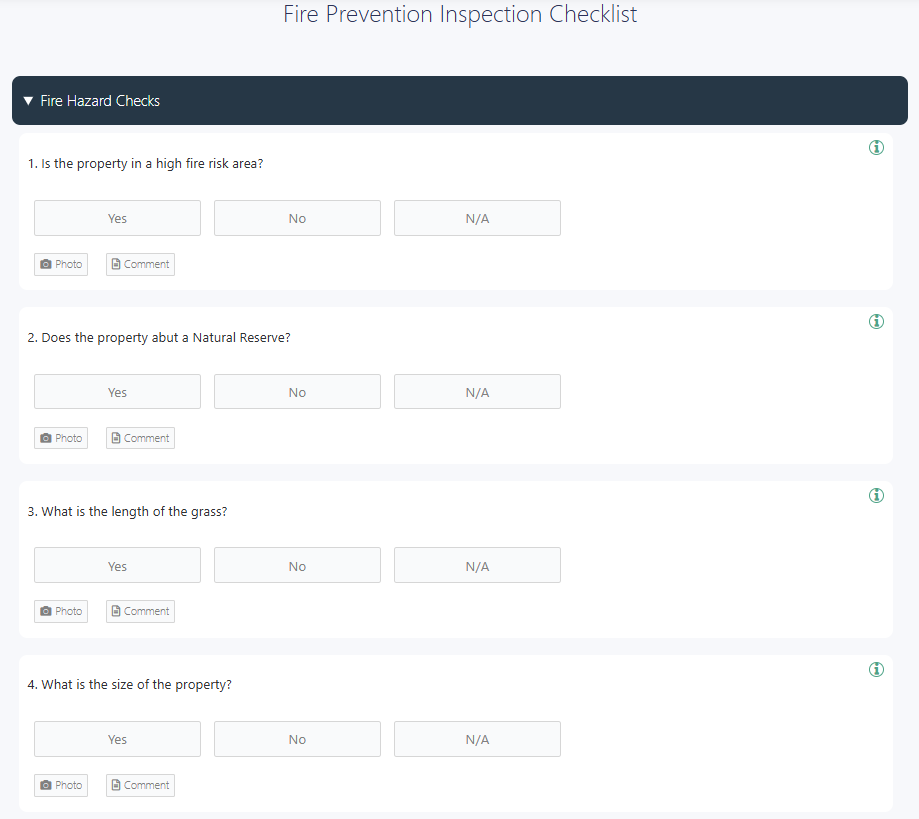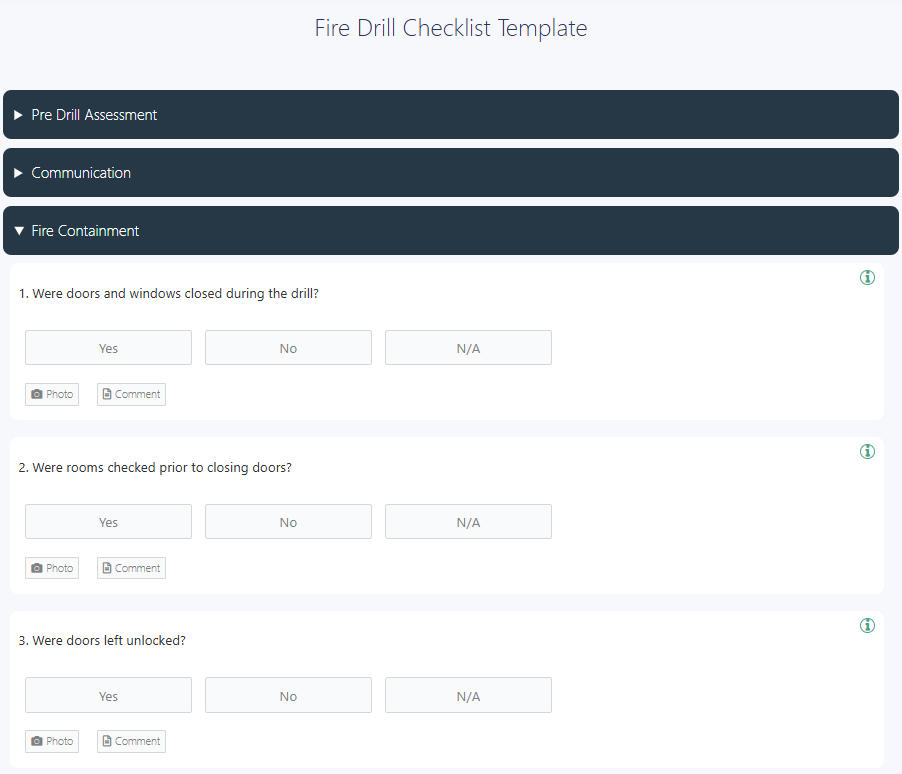Fire emergencies pose significant threats to workplace safety, potentially leading to severe injuries, property damage, and operational disruptions. To mitigate these risks, implementing comprehensive fire standard operating procedures (SOPs) is essential. Fire safety SOPs act as structured guidelines outlining preventive measures, emergency responses, and recovery strategies to ensure the safety of personnel and assets. Developing and following such SOPs can help organizations comply with legal requirements and also create a culture of safety. It significantly reduces the likelihood of fire incidents and enhances the organization’s preparedness against potential emergencies.
This article will dive into the essential elements, importance, and steps to develop fire SOPs.
What are Fire Standard Operating Procedures
Fire standard operating procedures (SOPs) are detailed, written guidelines designed to ensure a systematic, safe, and effective response to fire incidents. They cover various aspects of fire safety, prevention, emergency response, and post-incident activities. They provide a structured framework that is essential for ensuring safety and operational efficiency in any organization and guiding actions during fire emergencies.
Why are Fire Safety SOPs Important?
Here are some reasons why fire safety SOPs are important:
- Fire SOPs establish uniform procedures across all departments, ensuring every team member understands their role during a fire emergency. This operational consistency reduces confusion, enhances coordination, and ensures fire safety measures are applied uniformly across shifts and personnel changes.
- Well-defined SOPs streamline fire safety processes, eliminating unnecessary steps and reducing response times. Efficient procedures reduce errors, minimize downtime during drills and actual emergencies, and ensure quick and effective action.
- Fire SOPs provide clear instructions that help employees understand emergency procedures. Regular drills and training programs based on these SOPs reinforce knowledge, build confidence, and ensure that staff can act decisively during real incidents.
- In emergencies, time is critical. Fire safety SOPs offer step-by-step guidelines for various scenarios, outlining evacuation routes, assembly points, and communication protocols. By following these procedures, organizations can significantly speed up fire safety procedures and reduce risks to life and property.
- Fire SOPs help organizations comply with legal and regulatory requirements. Many jurisdictions mandate specific fire safety measures, and having documented SOPs demonstrates due diligence, avoiding legal penalties.
👉 How are fire SOPs different from fire SOGs?
Fire SOPs are formal, detailed, and mandatory directives that outline exactly how tasks must be performed, with little to no room for interpretation. They are designed to ensure consistency and compliance, especially in situations where safety or regulatory requirements are paramount. Deviation from SOPs is generally not permitted without formal approval and may result in disciplinary consequences.
Fire standard operating guidelines (SOGs) are recommendations or frameworks that guide personnel on how to approach certain tasks. Fire SOGs are less rigid than SOPs, offering flexibility and professional judgment based on the situation and making deviations acceptable. Fire SOGs acknowledge that emergency scenes are dynamic and sometimes require adaptation to unique circumstances.
Key Components of Fire SOPs
A standard fire SOP format should include the following areas.
- Purpose and Scope
Clearly define the objectives of the fire SOP, outlining its intent to safeguard lives, property, and operations. Specify the areas, departments, and scenarios it covers, ensuring all stakeholders understand its applicability.
- Roles and Responsibilities
Assign specific duties to individuals and teams to ensure accountability during fire-related incidents. For instance, designate a fire safety officer to oversee fire prevention measures, conduct inspections, and coordinate emergency responses. Department heads should ensure their teams comply with fire safety protocols, while all employees must be trained to recognize hazards and respond appropriately.
- Fire Risk Assessments
Conduct regular assessments using fire risk assessment software to identify potential fire hazards within the facility. Evaluate the effectiveness of existing safety measures and update them as necessary. Engage all stakeholders in the assessment process to foster a culture of safety and awareness.
👉 GoAudits offers free fire risk assessment checklists. You can use such checklists to identify hazards, prevent fire incidents, prepare for emergencies, and ensure workplace safety.

- Fire Prevention Measures
Implement strategies to minimize the risk of fire outbreaks. These include controlling ignition sources by installing surge protectors, limiting the storage of flammable materials, and ensuring proper disposal of combustible waste.
👉 Use the GoAudits free Property Fire Risk Assessment to digitize fire prevention SOPs, perform regular hazard checks, identify risk levels, and prevent major incidents.

- Fire Detection and Alarm Systems
A fire SOP template should include:
- Fire alarm control panel (FACP)
- Smoke and heat detectors
- Manual call points
- Alarm sounders and visual indicators
- Communication systems
👉 Find out how GoAudits fire alarm inspection software can help you digitize your fire SOPs and simplify fire alarm inspections.
- Fire Suppression Systems and Firefighting Equipment
The fire SOP must detail the types of fire suppression systems and firefighting equipment available on-site. It should include maintenance schedules, locations of equipment, instructions for use, and minimum stocking levels. Clear guidelines should also be provided for the use of systems like sprinklers, foam, inert gas, fire extinguishers, fire doors, etc.
👉 You can try the GoAudits fire door inspection software and fire extinguisher inspection software to schedule regular inspections and maintenance checks and ensure all systems are ready for emergencies.
- Emergency Communication Plan and Evacuation Procedures
This section of a fire SOP template should outline how fire-related emergencies are communicated within the facility, including:
- Activation of alarms
- Notification of emergency services
- Use of public address systems
- Internal alert protocols
A fire evacuation SOP must detail exit routes, assembly points, designated fire wardens, and headcount procedures.
👉 GoAudits fire inspection software offers free and customizable checklists that can help you assess the effectiveness of your exit routes and emergency plans.
– Emergency Response Plan Checklist
– OSHA Emergency Action Plan Checklist
– OSHA Exit Routes and Emergency Planning Checklist
- Training and Fire Drills
A fire SOP template should outline the training requirements for all employees to ensure they are prepared to respond effectively in the event of a fire. In addition to clearly stating the frequency of training, it should include the proper use of fire extinguishers, identifying emergency exits, responding to alarms, and understanding role-specific duties. A fire drill SOP should also specify how fire drills are to be scheduled and conducted, including how participation is tracked, performance is evaluated, and results are used to improve future procedures.
👉 You can use this free fire drill checklist to plan, execute, and evaluate fire drills in your organization.

- Post-Incident Procedures
Lastly, a fire SOP template should contain steps for actions following a fire event, including the following:
- Incident reporting and investigation
- Root cause analysis
- Insurance documentation
- Site repairs
- Updates to the SOP based on lessons learned
How to Develop and Implement Fire SOPs?
Here’s a step-by-step guide to assist you in this process:
1. Plan and Assess Your Needs
Begin by identifying potential fire hazards in your workplace, such as flammable materials, faulty electrical equipment, and heat-producing processes. Evaluate the building layout, including exit routes and emergency access points. Consider the specific needs of all employees, including individuals with disabilities, to ensure safe evacuation for everyone.
2. Research National and Local Fire Safety Standards
Familiarize yourself with applicable fire safety regulations and building codes relevant to your jurisdiction. This includes standards for fire detection systems, suppression equipment, emergency lighting, and evacuation procedures. Consult with fire safety professionals to ensure the fire safety SOP aligns with legal requirements.
3. Involve Key Stakeholders
Identify and involve key stakeholders in the development of the fire safety SOP. This includes senior management, safety officers, human resources, and frontline employees. Clearly define roles and responsibilities to ensure accountability and effective implementation.
4. Develop the Fire Safety SOP
Draft the fire SOP with detailed instructions on fire prevention measures, emergency response actions, and evacuation protocols. Include information on the use and maintenance of firefighting equipment, communication plans during emergencies, and training requirements for staff. Ensure it is accessible and understandable to all employees.
5. Review and Test the SOP
Before finalizing the fire safety SOP, conduct fire drills to test the effectiveness of the procedures. Gather feedback from participants to identify any gaps or areas for improvement. Revise it accordingly and obtain formal approval from designated authorities within your organization.
6. Implement SOPs Using Digital Checklists
The transition from paper-based procedures to digital platforms to manage fire safety tasks more effectively. Digital checklists can help schedule regular inspections, track equipment maintenance, and ensure compliance with the fire SOP.
GoAudits offers a wide range of fire safety audit checklists that can streamline the implementation of fire safety procedures. You can use these digital fire SOP templates to schedule regular fire alarm checks, fire door inspections, fire extinguisher inspections, track equipment maintenance, and ensure ongoing compliance.
- Fire Safety Inspection Checklist
- Monthly Fire Extinguisher Inspection
- Fire Protection Equipment Checklist
- Fire Door Inspection Checklist
- Fire Pump Inspection Checklist
- NFPA 25 Fire Pump Inspection
- Fire Safety Risk Assessment Checklist
- Workplace Fire Safety Checklist
- OSHA Fire Protection Checklist
- Fire Extinguisher Checklist
- Fire Protection System Maintenance Checklist
- Fire Damper Inspection Checklist
7. Monitor, Evaluate, and Update
Regularly review the fire SOP to incorporate changes in regulations, building layouts, or organizational structures. Conduct periodic audits and drills to assess the effectiveness of the procedures. Encourage feedback from employees to identify potential improvements and ensure the fire safety SOP remains current and effective.
Digitize Your Fire SOPs with Fire Safety Inspection Software
Maintaining fire safety standards is paramount for any organization but traditional paper-based fire SOPs can be cumbersome, inefficient, and hard to update. GoAudits safety inspection software is an all-in-one digital solution to simplify audits and enhance fire safety management. It enables you to transition from outdated paper checklists to a dynamic, mobile-first system that offers real-time visibility, ensures compliance, and promotes a proactive safety culture. Here’s how:
- Replace paper checklists with interactive digital health and safety audit checklists. Choose from existing templates, customize them to meet your requirements, or create your own with a simple drag-and-drop method.
- Perform inspections up to 5 times faster directly from your smartphone or tablet, even without internet access. Whether you’re checking fire extinguishers, emergency exits, sprinkler systems, or alarms, every observation is time-stamped and geotagged, enhancing accountability and traceability.
- Eliminate manual reporting with automated, real-time reports that are instantly available upon completing an audit. These detailed fire safety reports include photos, comments, and assigned actions, ensuring nothing gets overlooked.
- Assign follow-up tasks automatically, set deadlines, and track resolution in real-time. Escalations, reminders, and progress tracking reduce response times and ensure timely remediation of fire safety risks.
- Make informed decisions with smart dashboards that highlight audit scores and performance, recurring issues, high-risk areas, and inspection trends.
Benefits of Using Fire SOP Templates to Develop Fire SOPs
Here’s how these fire SOP templates can significantly enhance your SOP development and documentation process:
- Fire SOP templates provide a foundational structure, eliminating the need to start from scratch. You can focus on tailoring content to your specific needs rather than building from the ground up, streamlining the creation process, and ensuring quick deployment of procedures.
- They offer a structured framework that minimizes the resources required for fire safety SOP development. It leads to reduced labor hours and associated costs. Moreover, standardized fire SOP templates facilitate easier updates and maintenance, ensuring long-term savings.
- Fire SOP templates align with industry regulations, such as OSHA and NFPA standards. It not only mitigates legal risks but also promotes a culture of safety and accountability within your organization.
- They are designed with adaptability in mind, allowing for easy customization to suit different facility types. It ensures that each fire safety SOP is relevant and effective in its specific context.
- A well-structured fire SOP is a valuable training tool for new personnel. Fire SOP templates promote collaboration by providing a clear framework for team input and review, leading to more comprehensive and effective procedures.
- Fire SOP templates streamline the process of updating SOPs, making it easier to incorporate changes and improvements. It’s crucial during audits or when adapting to new regulations, to ensure that your procedures remain current and effective.
- Using a standardized fire SOP template reduces the likelihood of overlooking important steps or information. It enhances the reliability of your fire SOPs, ensuring that all necessary components are addressed and that procedures are executed correctly.



